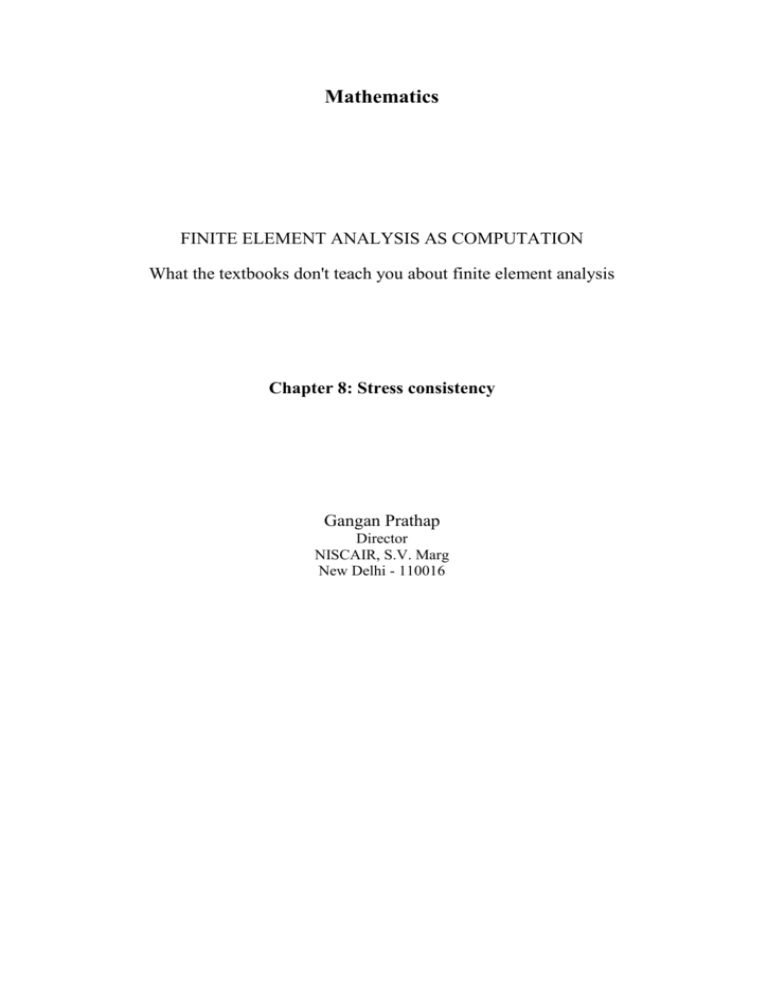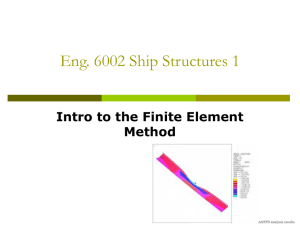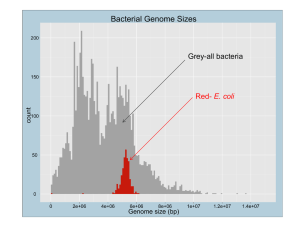Finite Analysis Chap 8- Formatted
advertisement

Mathematics
FINITE ELEMENT ANALYSIS AS COMPUTATION
What the textbooks don't teach you about finite element analysis
Chapter 8: Stress consistency
Gangan Prathap
Director
NISCAIR, S.V. Marg
New Delhi - 110016
Contents
8.1 Introduction
8.2 Variable moduli problems
8.2.1 A tapered bar element
8.2.2 Numerical experiments
8.2.3 Reconstitution of the stress-resultant field using the Hu-Washizu
principle
8.3 Initial strain/stress problems
8.3.1 Description of the problem
8.3.2 The linear bar element - Derivation of stiffness matrix and thermal
load vector
8.3.3 Example problem
8.3.4 A note on the quadratic bar element
8.3.5 Re-constitution of the thermal strain/stress field using the HuWashizu principle
8.3.6 Numerical examples
8.3.7 Concluding remarks
Chapter 8
Stress consistency
8.1 Introduction
In Chapters 6 to 7 we examined the difficulties experienced by the displacement approach to
the finite element formulation of problems in which some strain fields are constrained. To
obtain accurate solutions at reasonable levels of discretization, it was necessary to modify
these strain fields and use these in computing the stiffness matrix and also in stress recovery.
The criterion governing the relationship between the various terms in the modified strain field
interpolation was described as consistency - i.e. the strain field interpolations must maintain a
consistent balance internally of its contributing terms. This allows the constraints that emerge
after discretization to remain physically faithful to the continuum problem. This was the rule
that guided the locking-free design of all elements discussed so far.
In this chapter, we take a look at a class of problems where no constraints are imposed on the
strains but there is a need to relax the satisfaction of the constitutive relationship linking
discretised stress to discretised strain so that again a certain degree of consistency is
maintained. Such situations develop where there are structural regions in which the rigidity
varies spatially due to varying elastic moduli or cross-sectional area and also in initial strain
problems, of which the thermal strain problem is the most commonly encountered.
In structural regions with varying rigidity the spatial variation of strain-fields and stress or
stress-resultant fields will not match. In the discretization of such cases, it is necessary to
consider a form of external consistency requirement between the discretized strain fields and
the discretized stress or stress-resultant fields. This is necessary so that a correct
interpretation of computed stresses and stress resultants is possible; otherwise, oscillations
will be seen.
In initial strain problems, the initial strain variation and the total strain variations may be of
different order. This is a familiar problem in finite element thermal stress analysis. Here, it is
necessary to obtain kinematically equivalent thermal nodal forces from temperature fields
and also ensure that the discretised thermal strains corresponding to this are consistent with
the discretised description of total strains. Again, one must carefully identify the conflicting
requirements on the order of discretised functions to be used.
8.2 Variable moduli problems
8.2.1 A tapered bar element
We shall now conduct a simple numerical experiment with a tapered bar element to show that
the force field computed directly from strains in a structural element of varying sectional
rigidities has extraneous oscillations. A linear element would have sufficed to demonstrate
the basic principles involved. However, we use a quadratic tapered bar element so that the
extraneous oscillations, which for a general case can be of cubic form, are not only vividly
seen but also need special care to be reduced to its consistent form. In a linear element, this
exercise becomes very trivial, as sampling at the centroid of the element gives the correct
stress resultant.
We shall consider an isoparametric formulation for a quadratic bar element of length 2l with
mid-node exactly at the mid-point of the element. Then the interpolations for the axial
displacement u and the cross sectional area A in terms of their respective nodal values are,
u u2 u3 u1 2 u1 2u2 u3 2 2
A A 2 A3 A1 2
A1 2A2 A3
2 2
We shall first examine how the element stiffness is formulated when the minimum total
potential principle is used. We start with a functional written as,
1 2 N T dx W
where,
the axial strain,
E A x the kinematically constituted axial force,
pu dx the potential of external forces,
distributed axial load,
Young's modulus of elasticity
du dx
N
W
p
E
After discretization, will be a linear function of but N will be a cubic function of . The
strain energy of deformation is then expressed as,
U 1 2
N
T
dx
From this product the terms of the stiffness matrix emerge. Due to the orthogonal nature of
the Legendre polynomials, terms from N which are linked with the quadratic and cubic
Legendre polynomials, N3 and N4 respectively, will not contribute to the energy and therefore
will not provide terms to the stiffness matrix! It is clear that, the displacements recovered
from such a formulation cannot recognize the presence of the quadratic and cubic terms N3
and N4 in the stress field N as these have not been accounted for when the stiffness matrix
was computed. Hence, in a displacement type finite element formulation, the stresses
recovered from the displacement vector will have extraneous oscillations if N3 and N4 are not
eliminated from the stress field during stress recovery. We shall designate by BAR3.0, the
conventional element using N for stiffness matrix evaluation and recovery of force resultant.
Next, we must see how the consistent representation of the force field denoted by N must be
made. N should comprise only the terms that will contribute to the stiffness and strain energy
and the simplest way to do this is to expand the kinematically determined N in terms of
Legendre polynomials, and retain only terms that will meaningfully contribute to the energy
in N T . Thus, N must be consistent with , i.e. in this case, retain only up to linear terms:
N N 1 N 2
(8.1)
Such an element is denoted by BAR3.1. It uses N for stiffness matrix evaluation and
recovery of forces resultant. To see the variational basis for the procedure adopted so far, the
problem is re-formulated according to the Hu-Washizu principle which allows independent
fields for assumed strain and assumed stress functions.
8.2.2 Numerical experiments
We shall perform the computational exercises with the two versions of the element; note that
in both cases, the stiffness matrices and computed displacements are identical. Figure 8.1
shows a tapered bar clamped at node-1 and subjected to an axial force P at node-3. The taper
is defined by the parameters,
A3 A1 2A2 and A1 2A2 A3 2A2
Finite element results from a computational exercise using the two versions described above
for a bar with cross section tapering linearly from the root to the tip for which =0 are
obtained. Thus is given by,
A3 A1 A1 A3
Thus can vary from 0 to –1.0. Fig. 8.2 shows the axial force patterns obtained from the
finite element digital computation for a case with =-0.9802 (with A3=0.01 A1) It can be
noted here that the results are accurate at 1 3 .
Fig. 8.1 A cantilever bar modeled with a single element.
Fig. 8.2 Axial force pattern for linearly tapered bar (=0.9802 and =0.0) with A3=0.01 A1.
A general case of taper is examined next where A1=1.0, A2=0.36 and A3=0.04, and the area
ratios are =-4/3 and =4/9. Fig. 8.3 shows the results from the finite element computations.
Due to the presence of both quadratic and cubic oscillations, there are no points which can be
easily identified for accurate force recovery! Therefore it is necessary to perform a reconstitution of the force resultant fields on a consistency basis using the orthogonality
principle as done here before reliable force recovery can be made.
8.2.3 Reconstitution of the stress-resultant field using the Hu-Washizu principle
In forming the Hu-Washizu functional for the total potential, an as yet undetermined assumed
force function N is introduced but the assumed strain field can be safely retained as (note
that in a constrained media problem it will be required to introduce a field-consistent that
will be different from the kinematically derived and therefore usually field-inconsistent ) the functional now becomes
1 2 EA
T
N T dx W
Fig. 8.3 Axial force pattern for bar with combined linear and quadratic taper (=-4/3 and =4/9).
A variation of the Hu-Washizu energy functional with respect to the kinematically admissible
degree of freedom u, gives the equilibrium equation,
T
u dN dx p dx 0
Variation with respect to the assumed strain field gives rise to a constitutive relation
T
- N EA dx 0
(8.2)
and variation with respect to the assumed force field N gives rise to the condition
N
T
- dx 0
(8.3)
Now Equations (8.2) and (8.3) are the orthogonality conditions required for reconstituting the
assumed fields for the stress resultant and the strain. The consistency paradigm suggests that
the assumed stress resultant field N should be of the same order as the assumed strain field
. Then Equation (8.3) gives the orthogonality condition for strain field-redistribution.
On the other hand, orthogonality condition (8.2) can be used to reconstitute the assumed
stress-resultant field N from the kinematically derived field N. Now, Equation (8.2) can be
written as,
T
N - N dx 0
(8.4)
Thus, if N is expanded in terms of Legendre polynomials, it can be proved that N which is
consistent and orthogonally satisfies Equation (8.4) is obtained very simply by retaining all
the Legendre polynomial terms that are consistent with , i.e. as shown in Equation (8.1).
Thus the procedure adopted in the previous section has variational legitimacy.
8.3 Initial strain/stress problems
Finite element thermal stress analysis requires the formulation of what is called an initial
strain problem. The temperature fields which are imposed must be converted to discretised
thermal (initial) strains and from this kinematically equivalent thermal nodal forces must be
computed. The usual practice in general purpose codes is to use the same shape functions to
interpolate the temperature fields and the displacement fields. Thermal stresses computed
directly from stress-strain and strain-displacement matrices after the finite element analysis is
performed thus show large oscillating errors. This can be traced to the fact that the total
strains (which are derived from displacement fields) are one order higher than the thermal
strains (derived from temperature fields). Some useful rules that are adopted to overcome this
difficulty are that the temperature field used for thermal stress analysis should have the same
consistency as the element strain fields and that if element stresses are based on Gauss points,
the thermal stresses should also be based on these Gauss point values. This strategy emerged
from the understanding that the unreliable stress predictions originate from the mismatch
between the element strain and the initial strain due to temperature 0. We shall now show
that this is due to the lack of consistency of their respective interpolations within the element.
Earlier in this chapter, we saw that stress resultant fields computed from strain fields in a
displacement type finite element description of a domain with varying sectional rigidities
showed extraneous oscillations. This was traced to the fact that these stress resultant fields
were of higher interpolation order than the strain fields and that the higher degree stress
resultant terms did not participate in the stiffness matrix computations. In this section, we
show that much the same behavior carries over to the problem of thermal stress
computations.
8.3.1 Description of the problem
With the introduction of initial strains 0 due to thermal loading, the stress to strain
relationship has to be written as
D - 0 D m
(8.5)
The strain terms now need to be carefully identified. {} is the total strain and {m} is the
mechanical or elastic strain. The free expansion of material produces initial strains
0 T
(8.6)
where T is the temperature relative to a reference value at which the body is free of stress and
is the coefficient of thermal expansion. The total strains (i.e. the kinematically derived
strains) are defined by the strain-displacement matrix,
{}=[B]{d}
(8.7)
where {d} is the vector of nodal displacements. In a finite element description, the
displacements and temperatures are interpolated within the domain of the element using the
same interpolation functions. The calculation of the total strains {} involves the
differentiation of the displacement fields and the strain field functions will therefore be of
lower order than the shape functions. The initial strain fields (see Equation (8.6)) involve the
temperature fields directly and this is seen to result in an interpolation field based on the full
shape functions. The initial strain matrix is of higher degree of approximation than the
kinematically derived strain fields if the temperature fields can vary significantly over the
domain and are interpolated by the same isoparametric functions as the displacement fields. It
is this lack of consistency that leads to the difficulties seen in thermal stress prediction. This
originates from the fact that the thermal load vector is derived from a part of the functional of
the form,
D 0 dV
T
(8.8)
Again, the problem is that the `higher order' components of the thermal (or initial) stress
vector are not sensed by the total strain interpolations in the integral shown above. In other
words, the total strain terms "do work" only on the consistent part of the thermal stress terms
in the energy or virtual work integral. Thus, a thermal load vector is created which
corresponds to a initial strain (and stress) vector that is `consistent' with the total strain vector.
The finite element displacement and total strain fields which are obtained in the finite
element computation then reflect only this consistent part of the thermal loading. Therefore,
only the consistent part of the thermal stress should be computed when stress recovery is
made from the nodal displacements; the inclusion of the inconsistent part, as was done
earlier, results in thermal stress oscillations.
We demonstrate these concepts using a simple bar element.
8.3.2 The linear bar element - Derivation of stiffness matrix and thermal load vector
Consider a linear bar element of length 2l. The axial displacement u, the total strain , the
initial strain 0 and stress are interpolated as follows:
u u1 u2 2 u2 u1 2
(8.9a)
Fig. 8.4 Linear bar element.
u,x u2 u1 2l
(8.9b)
0 T1 T2 2 T2 T1 2
E u2 u1 2l E T1 T2 2 T2 T1 2
(8.9c)
(8.9d)
where x l (see Fig.8.4), E is the modulus of elasticity, A the area of cross-section of the
bar and the coefficient of expansion.
To form the element stiffness and thermal load vector, an integral of the form
T
(8.10)
dx
is to be evaluated. This leads to a matrix equation for each element of the form,
EA
2l
1
1
1
1
u1
T1 T2 1
EA
u
2
1
2
F1
F2
(8.11)
where F1 and F2 are the consistently distributed nodal loads arising from the distributed
external loading. By observing the components of the interpolation fields in Equations (8.9b)
to (8.9d) carefully (i.e. constant and linear terms) and tracing the way they participate in the
`work' integral in Equation (8.10), it is clear that the T2 T1 2 term associated with the
linear (i.e. ) term in (originating from 0) cannot do work on the constant term in T and
therefore vanishes from the thermal load vector; see Equation (8.11). Thus the equilibrium
equations that result from the assembly of the element equilibrium equations represented by
Equation (8.11) will only respond to the consistent part of the initial strain and will give
displacements corresponding to this part only.
If these computed displacements are to be used to recover the initial strains or thermal
stresses, only the consistent part of these fields should be used. The use of the original initial
strain or stress fields will result in oscillations corresponding to the inconsistent part. We
shall work these out by
Fig. 8.5 Clamped bar subject to varying temperature
hand using a simple example below and compare it with the analytical solution.
8.3.3 Example problem
Figure 8.5 shows a bar of length L=4l clamped at both ends and subjected to a varying
temperature field. We shall consider a case where two conventionally derived linear elements
are used, so that we require the nodal temperatures T1, T2 and T3 as input. The nodal reactions
are F1 and F3 (corresponding to the clamped conditions u1=u3=0). We have the assembled
equations as,
1 1
EA
1 2
2l
1
1
1
0 F1
EA
u2 0
2
0 F
3
T1 T2
T1 T3
T T
2
3
(8.12)
From this, we can compute the displacements and nodal reactions as,
u2 l T1 T3 2 and F1 F3 EA T1 2T2 T3 4
(8.13)
and these are the correct answers one can expect with such an idealization. If the stress in the
bar is computed from the nodal reactions, one gets a constant stress E T1 2T2 T3 4 ,
in both elements, which is again the correct answer one can expect for this idealization. It is a
very trivial exercise to show analytically that a problem in which the temperature varies
linearly from 0 to T at both ends will give a constant stress field ET 2 , which the
above model recovers exactly.
Problems however appear when the nodal displacement computed from Equations (8.12) is
used in Equations (8.9b) to (8.9d) to compute the initial strains and stresses in each element.
We would obtain now, the stresses as (subscripts 12 and 23 denote the two elements)
12 E T1 2T2 T3 4 E T2 T1 2
(8.14a)
23 E T1 2T2 T3 4 E T3 T2 2
(8.14b)
It is now very clear that a linear oscillation is introduced into each element and this
corresponds to that inconsistent part of the initial strain or stress interpolation which was not
sensed by the total strain term. This offers us a straightforward definition of what consistency
is in this problem - retain only that part of the stress field that will do work on the strain term
in the functional. To see how this part can be derived in a variationally correct manner, we
must proceed to the Hu-Washizu theorem.
8.3.4 A note on the quadratic bar element
We may note now that if a quadratic bar element had been the basis for the finite element
idealization, the total strains would have been interpolated to a linear order; the initial strain
and thermal stress field will now have a quadratic representation (provided the temperature
field has a quadratic variation) and the inconsistency will now be of the 1 3 2 type; thus
thermal stresses derived using a formal theoretical basis will show these quadratic oscillations
which will vanish to give correct answers at the points corresponding to 1 3 ; i.e. the
points corresponding to the 2-point Gauss integration rule.
8.3.5 Re-constitution of the thermal strain/stress field using the Hu-Washizu principle
We now seek to find a variational basis for the use of the re-constituted consistent initial
strain and stress interpolations in the Hu-Washizu principle.
The minimum total potential principle states the present problem as, find the minimum of the
functional,
MTP
T
m 2 P dV
(8.15)
where and m are as defined in (8.5) to (8.7) and the displacement and strain fields are
interpolated from the nodal displacements using the element shape functions and their
derivatives and P is the potential energy of the prescribed loads.
We now know that the discretized stress field thus derived, , is inconsistent to the extent that
the initial strain field 0 is not of the same order as the total strain field . It is therefore
necessary to reconstitute the discretized stress field into a consistent stress field without
violating any variational norm. In the examples above, we had seen a simple way in which
this was effected.
To see how we progress from the inconsistent discretized domain (i.e. involving 0 and ) to
the consistent discretized domain (i.e. introducing 0 and , it is again convenient to
develop the theory from the generalized Hu-Washizu mixed theorem. We shall present the
Hu-Washizu theorem from the point of view of the need to re-constitute the inconsistent 0 to
a consistent 0 without violating any variational norms. We proceed thus:
Let the continuum linear elastic problem have a discretized solution based on the minimum
total potential principle described by the displacement field u, strain field and stress field
(we project that the strain field is derived from the displacement field through the straindisplacement gradient operators of the theory of elasticity and that the stress field is derived
from the strain field through the constitutive laws as shown in (8.2). Let us now replace the
discretized domain by another discretized domain corresponding to the application of the HuWashizu principle and describe the computed state to be defined by the quantities , 0 and
, where again, we take that the stress fields are computed using the constitutive
relationships, i.e. D 0 . It is clear that 0 is an approximation of the strain field 0.
Note that we also argue that we can use as there is no need to introduce such a
distinction here (in a constrained media elasticity problem it is paramount that be derived
as the consistent substitute for .)
What the Hu-Washizu theorem does, following the interpretation given by de Veubeke, is to
introduce a "dislocation potential" to augment the usual total potential. This dislocation
potential is based on a third independent stress field which can be considered to be the
Lagrange multiplier removing the lack of compatibility appearing between the kinematically
derived strain field 0 and the independent strain field 0 . The three-field Hu-Washizu
theorem can be stated as,
HW 0
(8.16)
where
HW T m 2
T
m
m P
dV
(8.17)
where m 0 . At this stage we do not know what or 0 are except that they are to be
of consistent order with .
In the simpler minimum total potential principle, which is the basis for the derivation of the
displacement type finite element formulation in most textbooks, only one field (i.e. the
displacement field u), is subject to variation. However, in this more general three field
approach, all three fields are subjected to variation and leads to three sets of equations which
can be grouped and classified as follows:
Variation on Nature
u
Equation,
Equilibrium terms from P=0
Orthogonality
T
0 0 dV
(8.18a)
0
(8.18b)
dV 0
(8.18c)
(Compatibility)
0 Orthogonality
(Equilibrium)
0
T
Fig. 8.6 (a) Clamped bar under linear temperature variation and its (b) Bar element model, (c) Plane stress
model.
Let us first examine the orthogonality condition in (8.18c). We can interpret this as a
variational condition to restore the equilibrium imbalance between and . In this instance
this condition reduces to . Note that in a problem where the rigidity modulus D can
vary significantly over the element volume, this condition allows to be reconstituted from
in a consistent way.
The orthogonality condition in (8.18b) is now very easily interpreted. Since we have
consistent with , this condition shows us how to smooth 0 to 0 to maintain the same level
of consistency as . This equation therefore provides the variationally correct rule or
procedure to determine consistent thermal strains and stresses from the inconsistent
definitions.
Therefore, we now see how the consistent initial strain field 0 can be derived from the
inconsistent initial strain field 0 without violating any variational norm. We thus have a
variationally correct procedure for re-constituting the consistent initial strain field - for the
bar element above, this can be very trivially done by using an expansion of the strain fields in
terms of the orthogonal Legendre polynomials, as done in the previous section for the
consistent stress-resultants.
8.3.6 Numerical examples
In this section we take up the same example of a bar with fixed ends subjected to linearly
varying temperature along its axis and model it with the bar element and a plane stress
element for demonstrating the extraneous stress oscillations resulting from the lack of
consistency in initial strain definition.
A bar of length 8 units, depth 2 units subjected to a linear temperature distribution as shown
in Fig 8.6a is modeled first with two bar elements (see Fig 4. 18.6b). Let BAR.0 and BAR.1
represent the bar element versions with inconsistent and consistent thermal stress fields. As
already predicted, both give accurate displacements (-0.002 units at the mid point), see
Equation (9.13)); BAR.1 gives exact stress throughout while BAR.0 shows linear oscillations
(see Equations (8.14a) and (8.14b)) as shown in Fig 8.7.
Fig.8.7 Consistent and inconsistent thermal stress recovery for a clamped bar problem.
8.3.7 Concluding remarks
Before we close this section, it will be worthwhile to discuss the "correctness" of the various
approaches from the variational point of view. Note that Equation (9.2) and (9.3) would have
been fulfilled if an assumed stress-resultant field of the same order as N had been used in
place of the N of consistent order. This would result in the Hu-Washizu formulation yielding
the same stress predictions as the minimum potential principle. Thus, both N and N are
equally "correct" in the Hu-Washizu sense, but only N is "correct" with the minimum
potential energy formulation. Where they differ is in the consistency aspect - i.e. N is
consistent with whereas N isn't. It follows that from the theoretical point of view of the
variational or virtual work methods, the potential energy formulation and the Hu-Washizu
formulation describe the continuum physics in exactly the same way. Both the potential
energy and Hu-Washizu formulations are equally valid as far as variational correctness is
concerned. However, when approximations are introduced in the finite element method, the
Hu-Washizu formulation gives decidedly better results than the potential energy formulation
because of the flexibility it provides to modify stress fields and strain fields to satisfy the
consistency requirements in situations where they play a prominent role. Note that the
consistency paradigm, in this case that used to justify the truncation of N (obtained directly
from the displacement approach) to a consistent N on the argument that the truncated terms
are not sensed in the discretized strain energy computations, lies clearly outside the
variational correctness paradigm. Similarly, in the earlier chapters of this book, we saw
another variation of the consistency paradigm - the need to ensure a proper balance in the
discretized representation of constrained strain fields, which again lies outside the scope of
the variational correctness paradigm. It is very important to understand therefore that both
consistency and correctness paradigms are mutually exclusive but are needed together to
ensure that the finite element formulations are correctly and consistently done.
The stress field-consistency paradigm introduced here also applies to finite element
applications where certain terms in either the stress or strain fields do not participate in the
displacement recovery due to their inconsistent representation e.g. initial stress/strain
problems, problems with varying material properties within an element etc. In the next
section, we shall extend this paradigm to extract consistent thermal stress and/or strains from
a displacement type formulation.
In this section, we have demonstrated another variation of the consistency paradigm - in
applications to evaluation of stresses and stress resultants in finite element thermal stress
computations. It is shown that such stresses must be computed in a consistent way,
recognizing that the displacement type finite element procedure can sense only stresses which
have the same consistency as the total strain field interpolations used within each element.
Thus, in an element where the temperature field interpolations do not have the same
consistency as the strain fields, it is necessary to derive a consistent initial strain-field for
purposes of recovery of stresses from the computed displacement field. A simple and
variationally correct way to do this has been established from the Hu-Washizu theorem.







